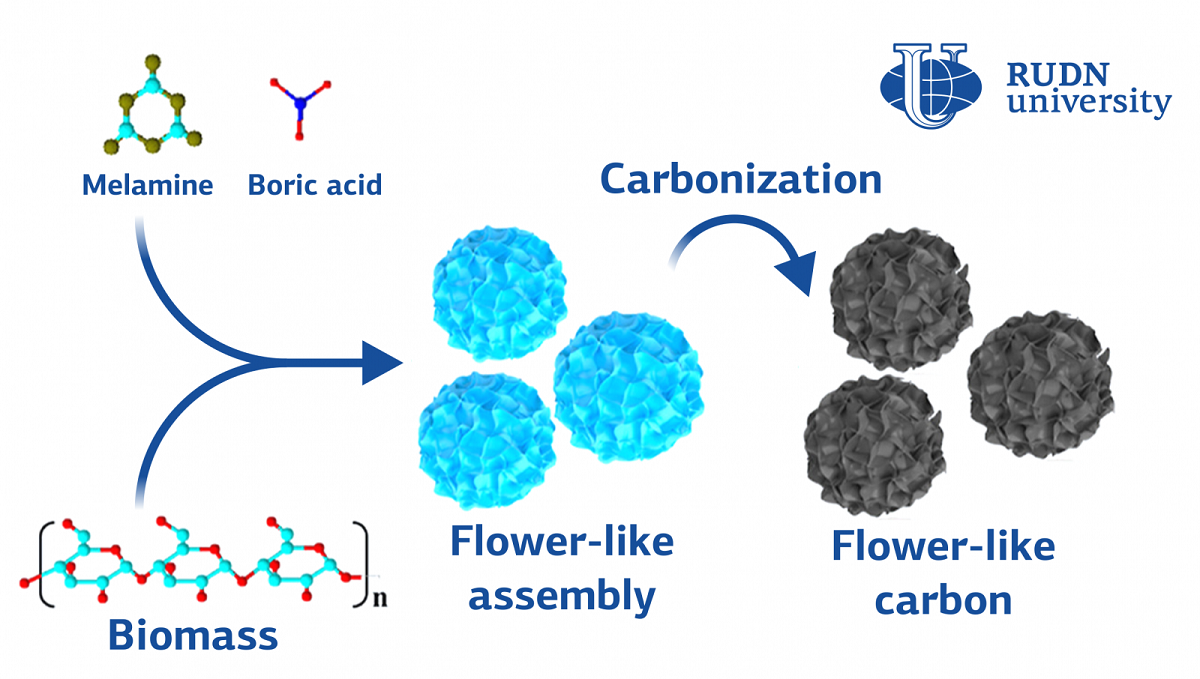RUDN Chemist creates carbon “flower” for zinc-ion supercapacitors

Supercapacitors can store up to 100 times more energy, than conventional batteries, charge faster, and withstand more recharge cycles. One of the most promising supercapacitors is zinc — ion. However, its real capacities, which are still possible to achieve experimentally, are significantly less than those calculated theoretically. This is due to the limitations of the characteristics of carbon compounds that are used as cathodes. To find the best carbon structure, scientists are investigating carbon nanotubes, chemically activated graphene, layered porous carbon, and hollow уuranium spheres. A RUDN chemist has proposed a new 3D-structure that will improve the properties of zinc-ion supercapacitors.
“Hybridization-based supercapacitors have attracted considerable attention as promising platformsа for optimizing energy storage devices. However, limited by the insufficient quality of carbon cathodes, the energy capabilities of zinc-ion supercapacitors are inferior to those expected, especially at high power output,” - Raphael Luque, Center for Molecular Design and Synthesis of Innovative Compounds for Medicine, RUDN University.
To get a new 3-D structure, chemists mixed melamine, boric acid and flour in water. The mixture was placed in an autoclave at 180 ° C for 15 hours. The result is structures similar in structure to carnation or hydrangea flowers — uneven balls with many pores. This “bouquet” chemists subjected to pyrolysis-for 2 hours heated, gradually increasing the temperature to 900 degrees. During pyrolysis, the auxiliary compounds in the “flowers” disintegrated, and only the carbon frame remained. Chemists performed similar procedures using flour and melamine, as well as only flour, as the starting compounds. All the resulting structures were studied using a scanning electron microscope. Then, using the resulting “flower” carbon (BCF), chemists made zinc-ion superconductors and measured its characteristics.
After comparing the structure of the obtained compounds, RUDN chemists concluded that boric acid did not affect the formation of the “flower” structure, and in fact оmelamine crystals and flour became the basis for it. It also turned out that BCF consists of many “nanolipes” — thin sheets connected to each other in a single ball structure. These bound nanolipes provided fast charge transfer within the flower and low resistance. The capacity of the BCF-based battery was larger than that of other similar devices — 133.5,5 mAh/ gram. The energy density (that is, the amount of energy that 1 kg of battery can store) also exceeded existing zinc-ion analogues.
“Suitable pores of the resulting carbon and the structure of its nanolipes ensure the penetration and exchange of electrolyte ions. Our research paves the way for creating carbon structures from individual carbon segments for energy storage devices,” - said Raphael Luque, Professor at the RUDN University Center for Molecular Design and Synthesis of Innovative Compounds for Medicine.
The results are published in the journal Carbon.
Matilda Pavlovna Mityaeva was born in 1925. In November 1942, she volunteered for frontline duty. She participated in the Great Patriotic War from November 1942 to June 1945 as part of the 53rd Infantry Division of the 475th Infantry Regiment. She was wounded twice.
The team led by Sergey Zyryanov, Head of the Department of General and Clinical Pharmacology, became the winner of the All-Russian competition of scientific projects "Technologies for Human Health".
RUDN University constantly adapts to the changes of the modern world and responds to challenges flexibly. This allows us to keep the standard of a world-class research university. The sphere of science is no exception. Peter Dokukin, Head of the Research Division, presented the updated R&D Programme at the meeting of the RUDN University Academic Council.
Matilda Pavlovna Mityaeva was born in 1925. In November 1942, she volunteered for frontline duty. She participated in the Great Patriotic War from November 1942 to June 1945 as part of the 53rd Infantry Division of the 475th Infantry Regiment. She was wounded twice.
The team led by Sergey Zyryanov, Head of the Department of General and Clinical Pharmacology, became the winner of the All-Russian competition of scientific projects "Technologies for Human Health".
RUDN University constantly adapts to the changes of the modern world and responds to challenges flexibly. This allows us to keep the standard of a world-class research university. The sphere of science is no exception. Peter Dokukin, Head of the Research Division, presented the updated R&D Programme at the meeting of the RUDN University Academic Council.